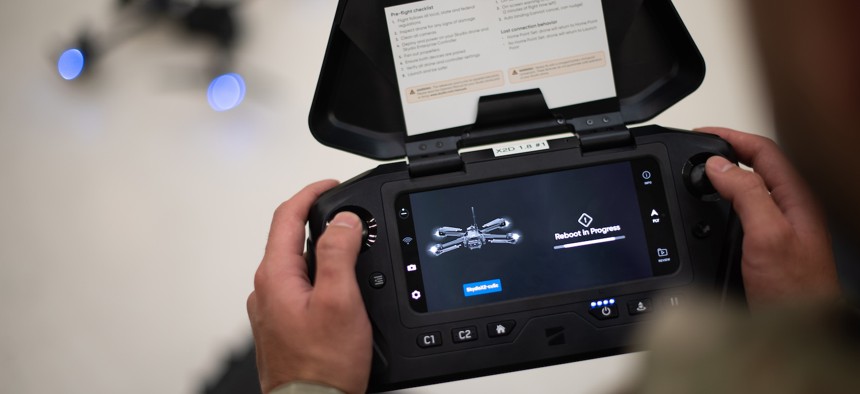DIU orders software to drive massive drone swarms

A U.S. Air Force member performs a system reboot before flying a Skydio X2D drone during a drone aircraft inspection program training at Travis Air Force Base, Calif., July 16, 2024. U.S. Air Force / Airman 1st Class Robert Nichols
The software glue holding the Replicator effort together is beginning to harden.
Three companies will produce prototype software to control the massive drone swarms envisioned by the Replicator rapid-production initiative, the Defense Innovation Unit announced on Wednesday.
The awards to Anduril Industries, L3Harris Technologies, and Swarm Aero are part of the initiative's Autonomous Collaborative Teaming, or ACT, effort, which is seeking “automated coordination of swarms of hundreds or thousands of uncrewed assets across multiple domains,” DIU said in a statement.
While Replicator hardware gets lots of attention, its software is every bit as important, Aditi Kumar, DIU's deputy director for strategy, policy, and national security partnerships, said earlier this month at a Defense One event. And, she said, DIU’s short calendar for testing new drone integration platforms and software is another challenge.
“We are buying this capability independently of the hardware systems, and so we need to be able to have open architectures, government-owned architectures, to ensure that the software that we're bringing in is one being upgraded and then integrated into all manner of hardware systems, which may then require their own hardware fixes to enable that. That is something we're going to test out as we mature these integrated enablers. We are going to demonstrate their integration with the other systems in the Replicator portfolio across multiple domains, and we'll be able to test that out.”
Anduril’s Lattice platform is one of the winners. In a statement, Anduril said it has completed a variety of real-world tests with military partners, such as in the U.S. Pacific Fleet’s Integrated Battle Problem 24.1 exercise, in which Navy operators used Lattice to integrate more than a dozen uncrewed systems and data feeds. Another example is CENTCOM’s Desert Guardian 1.0, where Anduril integrated “10 different sensor teams into Lattice, merging real-time data sharing, fusion, and tasking across diverse sensor systems” to more quickly detect airborne and other threats. And in Army’s EDGE23 test, Lattice allowed a single soldier to “manage an integrated team of multiple uncrewed aircraft to locate, identify, and destroy a surface-to-air missile site,” according to Anduril.
DIU also made awards for part of another Replicator-related effort dubbed Opportunistic, Resilient & Innovative Expeditionary Network Topology, or ORIENT, to ensure communications for drones in a heavy electromagnetic warfare environment. The awards went to Viasat, Aalyria, Higher Ground, and IoT/AI.
Will Replicator prevent World War III?
The Defense Department launched Replicator specifically to deter Chinese military action in the Pacific. At a Pallas Foundation event on Wednesday, Adm. Sam Paparo, the head of U.S. INDOPACOM, discussed the role that autonomous systems could play in deterrence—a role similar to the one Ukraine’s maritime drones are playing in the Black Sea.
“One need not actually achieve complete air and maritime superiority over a space when an adversary is trying to gain it. One need only perhaps deny it to the other, and can potentially do that at low cost,” Paparo said. “We've seen that actually in practice, and have learned from that, from Ukraine in the Black Sea, where a Slava cruiser was destroyed and sunk [by a Ukrainian sea drone.] And it's important that we learn that lesson from that and the Black Sea.”
Paparo also outlined how he might use different levels of autonomy for different missions as part of that deterrence effort. For offensive missions, maintaining human control is critical, he said. But for fleet defense, more autonomy could help speed reaction time.
“For instance, if a raid of ballistic missiles is approaching your unit, this is a time when you would want your system on full auto, carrying those arrows that are coming in. On the other hand, if you are executing a complex attack on an enemy system, this would be a case where you want to do so very circumspectly, because you're taking lives.”


